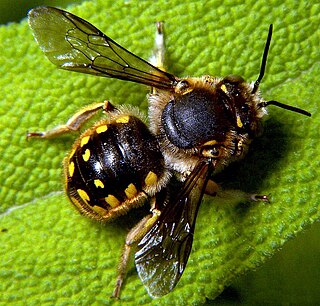
Megachilidae is a cosmopolitan family of mostly solitary bees. Characteristic traits of this family are the restriction of their pollen-carrying structure to the ventral surface of the abdomen, and their typically elongated labrum. Megachilid genera are most commonly known as mason bees and leafcutter bees, reflecting the materials from which they build their nest cells ; a few collect plant or animal hairs and fibers, and are called carder bees, while others use plant resins in nest construction and are correspondingly called resin bees. All species feed on nectar and pollen, but a few are kleptoparasites, feeding on pollen collected by other megachilid bees. Parasitic species do not possess scopae. The motion of Megachilidae in the reproductive structures of flowers is energetic and swimming-like; this agitation releases large amounts of pollen.
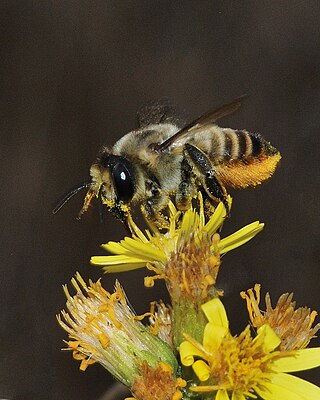
The genus Megachile is a cosmopolitan group of solitary bees, often called leafcutter bees or leafcutting bees; it also includes the called resin bees and mortar bees. While other genera within the family Megachilidae may chew leaves or petals into fragments to build their nests, certain species within Megachile neatly cut pieces of leaves or petals, hence their common name. This is one of the largest genera of bees, with more than 1500 species in over 50 subgenera. The alfalfa leafcutter bee is managed on a commercial scale for crop pollination, and has been introduced by humans to various regions around the world.

Megachile campanulae, known as the bellflower resin bee, is a species of bee in the family Megachilidae. Described in 1903, these solitary bees are native to eastern North America. Studies in 2013 placed them among the first insect species to use synthetic materials for making nests. They are considered mason bees, which is a common descriptor of bees in several families, including Megachilidae. Within the genus Megachile, frequently also referred to as leafcutter bees, M. campanulae is a member of the subgenus Chelostomoides, which do not construct nests from cut leaves, but rather from plant resins and other materials. Females lay eggs in nests constructed with individual cell compartments for each egg. Once hatched, the eggs progress through larval stages and subsequently will overwinter as pupae. The bees are susceptible to parasitism from several other bee species, which act as brood parasites. They are medium-sized bees and the female adults are typically larger than the males. They are important pollinators of numerous native plant species throughout their range.
Megachile angelarum is a species of bee in the Megachilidae family.
Chelostomoides is a subgenus of bees in genus Megachile. These bees do not cut leaves, but rather, use resin, mud, or other materials
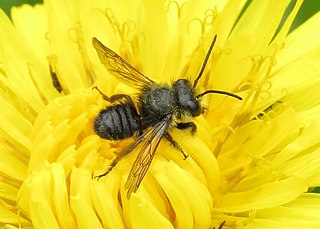
Megachile amparo is a species of bee in the family Megachilidae. It was described by Gonzalez in 2006.

Megachile gentilis is a species of bee in the family Megachilidae. It was described by Cresson in 1872.

Megachile rubi is a species of leaf cutting bee in the family Megachilidae, found in the eastern United States. First described by Mitchell in 1924, it is placed in the subgenus Xeromegachile, members of which are most often found in sandy areas and have distinct preferences in the petals and leaves they use in their nests.

Megachile texana, the Texas leafcutter bee, is a species of bee in the family Megachilidae. It was first described by the American entomologist Ezra Townsend Cresson in 1878. It is native to the United States and southern Canada.
Megachile turbulenta is an invalid species of bee in the family Megachilidae. M. turbulent was described by Mitchell in 1930. Megachile turbulenta has no common name.
Megachile venusta is a species of bee in the family Megachilidae. It was described by Smith in 1853.

Megachile versicolor is a species of bee in the family Megachilidae. It was described by Smith in 1844.
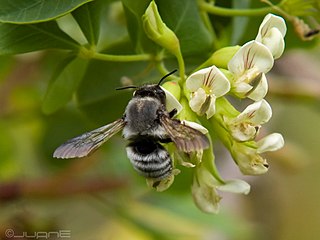
Megachile canescens is a species of bee in the family Megachilidae. It was described by Brullé in 1832.
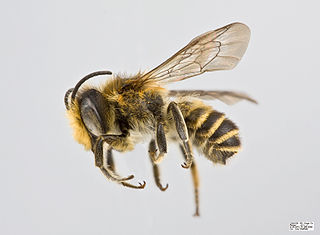
Megachile centuncularis, commonly known as the patchwork leafcutter bee, is a species of bee in the family Megachilidae. It was first described by the Swedish naturalist Carl Linnaeus in 1758.
Megachile cheesmanae is a species of bee in the family Megachilidae. It was described by Charles Duncan Michener in 1965.

Megachile mystaceana, the fire-tailed resin bee, is a species of bee in the family Megachilidae. It was described by Charles Duncan Michener in 1962.

Megachile parietina is a species of bee in the family Megachilidae. It was described by Geoffroy in 1785. It is native to most of central Europe, as well as parts of eastern Europe.
Megachile umatillensis is a species of bee in the family Megachilidae. It was described by Mitchell in 1927.

Megachile willughbiella, Willughby's leaf-cutter bee is a species of bee in the family Megachilidae. It was described by the English entomologist William Kirby in 1802; he named it in honour of the ornithologist Francis Willughby.












